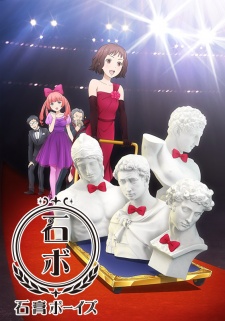
“The term ‘idol’ refers to heavily promoted singers, actors, and celebrities who draw a devoted fanbase that worship them like gods on earth, a pretty obvious parallel to the original religious definition pertaining to subjects of worship.” I can only imagine that whoever came up with the idea for Sekkou Boys must have said this exact line while attempting to suppress their full-on laughter in vain. Yes, after Saint Onii-sama and Thermae Romae breached the subject of using classic religious and historical figures in a completely out-of-place comedy, it was only natural for someone to get around to putting a group of figures like Saint George, Medici, Mars, and Hermes, so immortalized that they may as well be true idols in the original sense of the word, into a boy band.
To make the times and places meet, they even came up with the clever idea of using sculpted busts instead of the real people, contrasting unmovable faces with a range of emotions told only through shading and tone. In addition, the concept of pampering idols goes a whole other step, as their unfortunate manager Ishimoto (literally "made of rock") is forced to physically carry them wherever they go. They also indulge in secret affairs, ride marketing trends, and even run a pyramid scheme in the background, all to play up the ridiculous life of celebrities. Electronic artists, teen pop idols, and veteran enka singers all come in and out of the story, making for an incongruous setting even without the singing sculptures at the center.
Given that Sekkou Boys is a short there is barely enough time to give them each some time to monopolize the spotlight before showing their daily mayhem of appearing on talk shows, live performances, dramas, and everything else they need to claw their way to fame. The sculpture joke runs in parallel as boddhisatvas monopolize TV, Moliere and Brutus show up for a comedy duo, and Ishimoto finds her way forward thanks to an Agrippa statue she locked in her closet after her traumatic college years of painting sculptures all day. So there are idol jokes and sculpture jokes, and perhaps it is its own joke that the two never intersect, as if no one is surprised by a singing group of classic Western figureheads.
Yet there’s not much else. The idol jokes are simply caricaturizing the busy lives of real idols, while the sculpture jokes are simply to insert more unlikely busts where none belong. The concept is humorous because of how bizarre a simple pun on the word “idol” can turn out to be. But what actually happens? This reminds me of Miss Monochrome, where a one-off joke, about switching out real idols for crazy substitutes and then playing the rest like a typical idol comedy, is stretched out for the sake of making the same joke a few more times. While Sekkou Boys is certainly the better of the two, it scarcely changes the fact that any two episodes, particularly the first two, are funny and enjoyable for the same reasons that watching all twelve just isn’t.